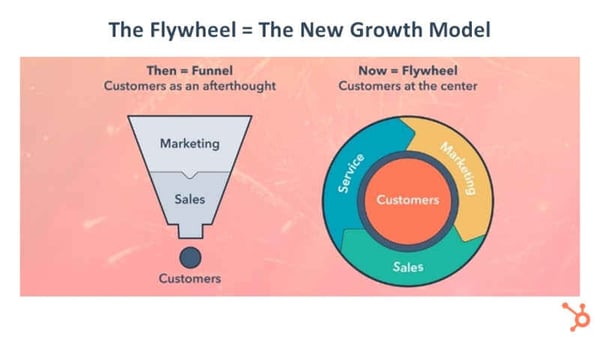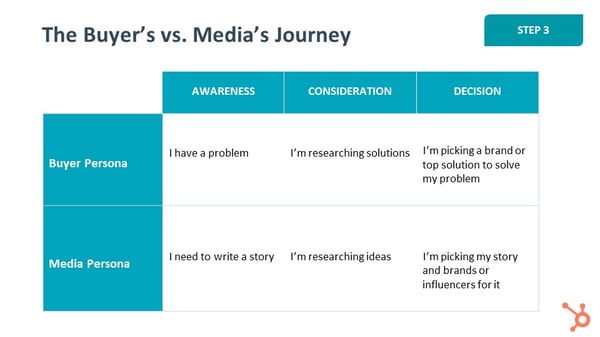Getting Started With Inbound PR
- Home
- Getting Started With Inbound PR
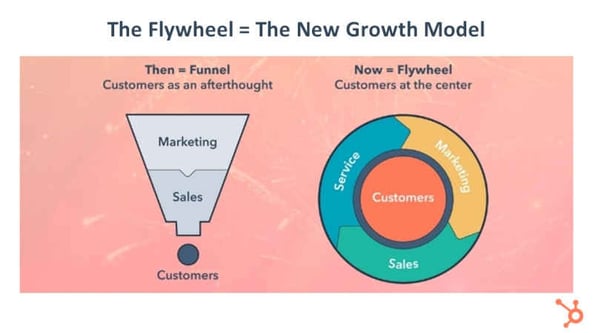 We’re here to talk about inbound PR and give you some very practical tips, having worked with over 200 HubSpot marketing agencies to consult and help them grow their businesses with inbound.
We’re here to talk about inbound PR and give you some very practical tips, having worked with over 200 HubSpot marketing agencies to consult and help them grow their businesses with inbound.
For many years, PR has been overcome by fear of not jumping on the bandwagon and then changing. Granted, there are a lot of professionals and a lot of PR agencies as well who are doing a great job and learning from other practices like inbound marketing, jumping on the bandwagon of social media, etc., but as an industry, PR has normally stayed behind other industries and hasn't really adopted with the world of digital. Overcoming fear is key for that as well as testing, trying, experimenting and learning – that's how we progress.
We’ll walk through PR and why we feel it's broken. We mentioned that already a little bit so we'll dig a little bit deeper. We'll talk about how inbound can help and then focus on some practical tips that you can go ahead and try. A lot of them align with the inbound marketing methodology that all of you who are HubSpot customers are familiar with and for others it's pretty easy to explain as well. We hope you can take a lot from this, go do it at home and try it for yourself as you are getting started with HubSpot marketing and PR. Let’s dive right in.
Why Is PR Broken?
Whenever we try to explain an industry, we start with its definition. If we look at the PRSA, which is the Public Relations Society of America – the biggest PR body in the world – they define PR as a “strategic communication process that builds mutually beneficial relationships between organisations and the public.”
Let me show you another definition that's a little bit more popular. It doesn't come from a PR person and it says that advertising is basically saying that you're good, whereas PR is getting other people to remark about you and say how good you are. That's that whole influencer talk that we spoke about earlier on. Now how many agree with this statement? PR is the same as media relations? Media relations is basically working with journalists to get coverage out there.
That's been the general notion for PR for many years. PR has been taken as synonymous with media relations. Now digital marketing has changed. A landscape is different, with different types of media nowadays.
- PR is no longer just media relations: We still have earned, so that's media relations where we work with those journalists, but then we also work with different types of influencers. We also have shared, which is social media. We have owned media, which is really where inbound marketing comes into play because email marketing is all about our own content. And with paid media, I think you are now well aware as well of Facebook and Instagram and Twitter paid posts and LinkedIn.
On a lot of occasions, when we do PR, earned is a lot of what we think about. But for us, we think that’s dead. As we said, the media types have evolved, we as customers and consumers of information are very different from what we used to be before, and we make decisions differently. The whole notion that a lot of people have about PR, and really how the practice was for years, where you just mass e-mail a list of 500 journalists with a press release, and expect five pieces of coverage just doesn’t work.
- Traditional PR is Outbound: It’s similar to the outbound world that we had with inbound marketing, where we used to use tactics like direct mail and basically spam people with information not at the right time, the wrong type of information, really when they’re not interested in it.
We want the industry to change. This is a quote that we really love from a couple of years ago that still plays a role to day, and it says that “PR needs to reinvent itself,” because if PR doesn’t adapt to the new world of new media types of the digital reality, basically the discipline will die out. Now, we don’t think that’s necessarily going to happen – we said the industry is slow to adapt. We’re at the right time now to look at what else we can do to reinvigorate the industry and show them that PR can be super influential and helpful to the bottom line. That’s where we think inbound can play a role.
How Inbound Can Help
The whole premise of this came from the realisation that various agencies from different backgrounds – SEO, content, web, digital, etc. – are really struggling with content creation whereas all the PR agencies had no problem with that. That’s pretty clear to all of us. PR people – what do they do? They create content. They create stories. To give you the stats on that, the latest CIPR state of the profession report show that day in, day out, this is what PR people do: 76% of them spend some or most time copywriting and editing. It really is content.
Now we said a little earlier that PR people are not so great at measurement. A lot of PR professionals have still stuck with advertising value equivalence, where you’re basically looking at how much you’re paying for that ad, and for the space in a magazine or etc., any outlet, and then you’re comparing, if that ran an ad, that’s what the outcome would be of your PR efforts.

You will also see from another research that 73% of PR professionals say that aligning metrics to revenue is vital but it's also the most difficult challenge that they're facing. That's consistent. If you look at various different studies about PR, you see that that's what has always been the case. It's always up in the 70s, the 80s, as in the number that this is the biggest challenge.
Essentially, inbound PR is about combining what PR is great at – which is content – and alleviating biggest challenge – measurement – through everything that inbound marketing preaches and teaches us. We know that inbound marketing works – we've seen that before, right? It's like we attract people, create a lot of the awareness content – which to a big part PR can and should be responsible for – generating their leads, we nurture them, we put them through a whole sales process and then we drive revenue.
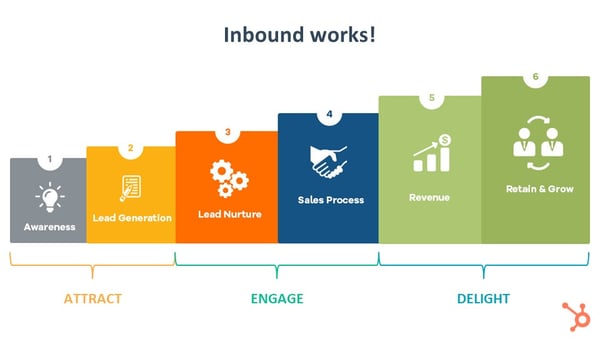 Of course we don't forget the last part where we need to engage with them continuously because we now know that our customers are the biggest driver of growth. For those of you that came to inbound last year, we killed the funnel. Do you guys like that? Do you think we should kill the funnel?
Of course we don't forget the last part where we need to engage with them continuously because we now know that our customers are the biggest driver of growth. For those of you that came to inbound last year, we killed the funnel. Do you guys like that? Do you think we should kill the funnel?
The Inbound PR Methodology
We killed the funnel and now we have the flywheel and the flywheel spins. The more force you put into any of those, the more it's gonna spin. That's what we really want to do with inbound marketing, but also within inbound PR. If we look at the methodology for inbound PR, you notice that it's rather similar to inbound marketing and that's on purpose, but it uses different tools.
- Attract: If you're looking at attract, it’s a lot of content creation right? That's on your website, that's blogging, and those press releases – they're not bad, they just need to be used in a better way. We still have that SEO piece, social media, video ads, and Knowledge Base when it comes to customers.
- Engage: The engage tools focus a lot on that engagement and direct conversations through email. The newsroom plays a big role and we’ll talk about that later.
- Delight: Of course that continues with the social media engagement. It would be inclusive and about really creating that relationship.
What’s truly unique about PR is that PR can work with any stakeholder group. Whereas inbound marketing really focuses only on those prospects – on those customers that you want to acquire – PR can be any persona. It can be the customers, it can be the media (those would include journalists and influencers and bloggers and youtubers, etc.), can be investors – really any stakeholder group. That's what makes PR the most unique industry of them all out there, which concerns anything around digital.
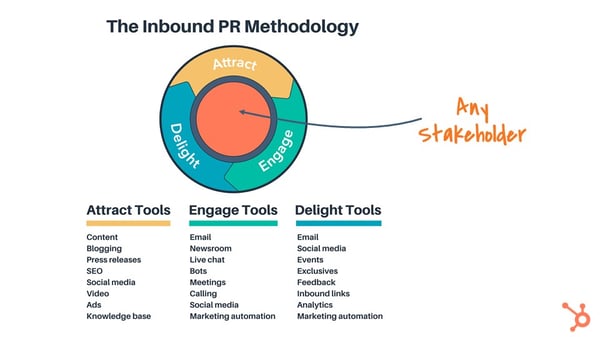
We've got the methodology in and I know that that gives you a lot of ideas on what type of tools you can use, etc., but we said in the beginning that we want to leave you with some very practical tips on how to do that, and not just a methodology.
How To Do Inbound PR
There are eight steps. They're pretty simple steps. You can follow each one from beginning.
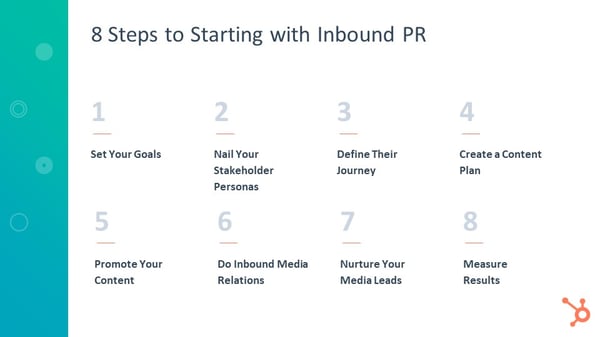
We start with setting goals – that's important whenever we do anything that we want to have an impact on our business. We nail stakeholder personas – for HubSpot customers, you know the word persona. We define their journey, we create content, and we promote it. We do inbound media relations. Because we're talking about PR, we don't want to lose that – your earned media track. We nurture them and then at the end we measure the results. That's a closed loop, right? That spins around in itself as a flywheel.
- Set Your Goals: As we said, that's the most important thing and you need to spend a lot of time defining those goals and making sure you're comfortable with them because if you don't have the right goals, you're not going to be able to define the right tactics and in the end you're going to be like, “Well this doesn't work for me.” Of course it doesn't work for you because you haven't set the right goals. The biggest question you need to ask is “Why?” and there's a whole book called Why? that asks you to ask ‘why’ five times and you should definitely do that here. Why are we doing this? What's the purpose? Why do we even need PR? What do we hope to achieve with it? What's the type of revenue we expect with it or not? We need to be very clear on that because when there's confusion, then people are not happy and especially if you're an agency trying to provide a service to a customer, you have to be very aligned on those goals that you’re setting there together.
You also want to know specifically how much inbound PR is supposed to help you. We’re a firm believer that inbound PR can drive revenue and it can do that through various ways, whether PR is going to tackle the whole prospect persona, whether they're going to work with the media or people, or whether you're going to use PR collateral in your sales process. You have to be very clear on that and have clear expectations on what you are trying to achieve.
- Nail Your Stakeholder Personas: After that, you want to nail your stakeholder personas. These things are very much related. For instance, when you decide on your goals and what you’re trying to achieve, you can say, “All right, now I'm going to work with these type of personas.” You may have multiple. You can work with your prospects. You can work with a media persona. If you want to do something with investors, that's also fine, but you have to be very clear on that. Who are those ideal people you're trying to reach? You need to go a level deeper there.
What we've seen is that a lot of people when they come to this step, they say, “Oh yeah, that makes sense. I’ll define my personas. That's kind of like my target audience. Yeah, that's all good. We've actually got some ideas.” And so you end up with assumptions rather than research. Some agencies would be very quick in jumping on it and creating a whole persona profile for the prospects and then when asked how they went about doing this, the answer is, “Well we sat together here, our team and we discussed it and we came up with this.”
Did you ever ask your customers? Did you ever research them online? Did you dig into reports for some user behaviour online? Did you interview them? Did you survey them? Typically the answer would be “No,” and then your content doesn't work because what you're trying to achieve with any type of content creation is to answer the questions that your personas are having and you want to save them time because people don't have time right now. You’ve got to be very specific on what those questions are and you want to answer them.
We also mentioned that we don't want to lose the whole media perspective even though we believe that PR has evolved with the different media types, so we’ll focus on the media persona here right now for the purposes of this, but it's very similar to what you have already done with the buyer personas, specifically those of you who are HubSpot customers.
When it comes to defining a media persona, you want to know who those journalists, bloggers, YouTubers and, generally, influencers are who might be interested in your business, products and services. What does a day in the life look like? If those are bloggers, then they'd have very different days than that of journalists who work in the newsrooms. How do they prefer to be contacted? That's key. A lot of people ignore their emails and spam it.

For me, for example, I said that I have a blog and I get pitches five or six times a week. Most of them come in my email inbox and then I completely ignore them. I don't have time for my work inbox, let alone for my personal inbox and so the best way to contact me, for example, is to actually send me a Twitter message. I'll take a look at that if it's a quick pitch and then I can easily tell you, “Oh yeah, that works for me. Send me another email here and here.” Then I want to pay attention to you. A lot of influencers and the media people in general are like that. They have their own preferences. You need to understand them and the only way to actually know that is to ask them.
We want to know how they do research, like when they write a story. We do that as well when it comes to our prospects. We look at their entire online journey and we look at what they read and how do they consume it, who do they ask for recommendations, etc. You also want to know what they’re looking for in stories. Some journalists may be interested in data and facts, others may be more interested in interviews or customer stories, etc.
You also want to know what challenges they have. For some of them, they may need to turn around a story in 24 hours. Can you be just as agile? That’s important too. Well these are just some example questions. There are plenty that you can develop on your own as well, but the idea is that through asking those questions and doing your research, you can create a full picture of the persona you're trying to target and then you need to take that a level up with defining their journey.
- Define Their Journey: I'm sure you guys aware of the buyer's journey. It's the process someone goes through from understanding that they have a problem through researching the details of it and then deciding on a solution. That's very typical when it comes to email marketing, and it's the same when we go into inbound PR and looking at any other persona. So here again, we’ll focus on the media.
These guys, even if it's a YouTuber or blogger, they know I actually need a story, I need to create something here. They're researching their ideas. This is where you want to pop up, and then at the end they're going to pick the story and the brands that they want to work with. This is also again where you want to have persuaded them already because you answered the questions with your content that they found through their research journey.
- Create a Content Plan: Knowing the questions that they ask is also helpful when it comes to creating your content. Content creation is another area where we've seen a lot of people struggle because they don't do it strategically enough and they just start backwards. What we mean by that is a lot of people come up with lots of blog posts ideas, which are really great topics and they're good but they don't go back all the way and they sort of do it backwards. You need to be really strategic with this and you're going to have to create different content for different personas. Can you repurpose it? Yes.
The best way to start with content creation is to first start with your persona, define the questions they ask throughout their journey (these are your keywords), make sure you know which stage they relate to because that's going to help you later when it comes to lead nurturing, and then answer those questions with content offers. Content offers can be eBooks, webinars, anything on your newsroom, videos, etc. – something that's of higher value – and then you use your blog posts and press releases and other content on the newsroom as your promotional efforts. They are still content, but they're the ones that will actually be found online and will guide the person that persona to the content offer. It’s important to start that way and not backwards.
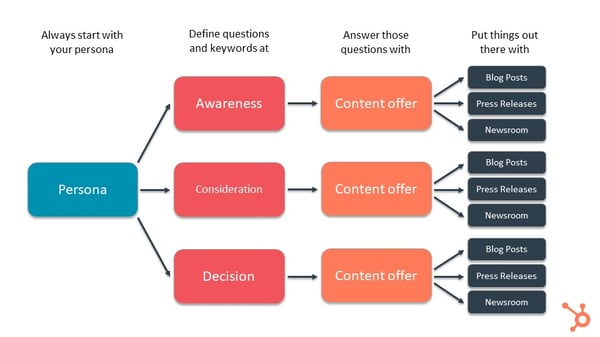
Once you have that, you will have a bunch of content ideas, a bunch of content out there, but you need to promote it. We live in a world where there's just so much information out there, everyone is very careful about what they consume and how they spend their time. That's why becomes really hard to actually decide how to promote the content.
The content format is important too. We mentioned a couple of examples already and depending on what type of industry you're in, you'd want to consider that too. You’ll be answering those questions that you personas are asking, but are you using the right format that they prefer? I love video right now but I don't have the patience to watch long videos, so if you give me a two minute videos, I'm okay with that. Ebooks really depend on the topic. You have to be conscious and you're going to have to test that with your personas too in terms of where they read, how to read, legitimately how they consume content and what type, as well.
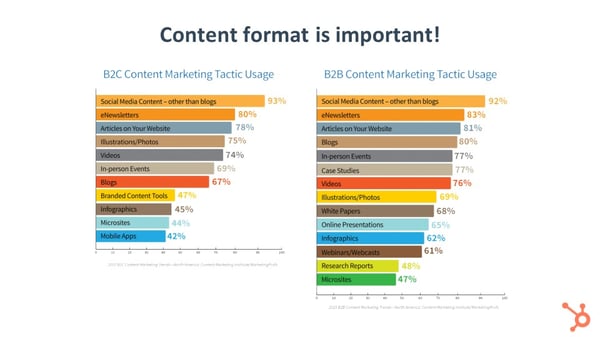
Speaking of video, we mentioned that earlier on, by 2020 video will make up more than 80% of consumer traffic. Are you guys surprised about that? Nope. Yeah, me neither.
- Promote Your Content: There’s way too much noise out there. How much time do you guys spend on social media? Too much? Yeah. It is so much. You get addicted, right? You scroll through that Facebook news-feed and you're just can't stop, but it is also how you get informed, right?
That’s also key. You actually want to go there where your personas are. This is a really cool graph that I always use in real life and it gets updated every year but when you look at the amount of content that's out there on each of those, for 60 seconds, it's insane. That's 18 million text messages. We are full-on addicted to our phones.
55% of the global population has internet access and they are probably active on one of those networks because on average we have 8.5 social media accounts. The equation really for successful content promotion is around 20% content creation and 80% content distribution. We get bogged down on creating new content and fresh content all the time, whereas actually what we should be focusing on is promoting that content.
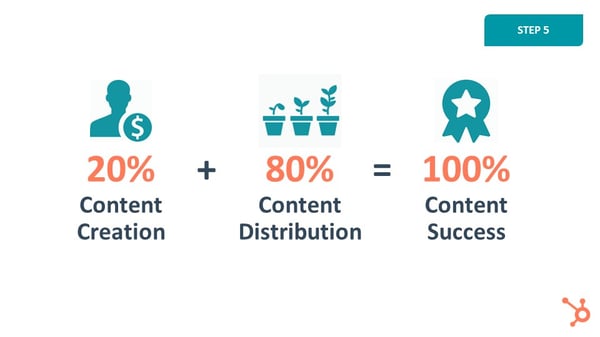
If you have a great video like the guys are doing right now and they're going to promote that, but they're also going to repurpose it and they're going to use it. They'll turn it into blogs, they'll turn into Facebook messages, they’ll cut it down into shorter videos, etc. There's so much you can do and consider that part of your content distribution as well because that content is already there – it's created. You just need to repurpose it. You need to get it out in front of the people where they actually like to consume it.
- Do Inbound Media Relations: One of the coolest things that I love when it comes to content distribution is the so-called PESO (Paid, Earned, Shared, Owned) model. It comes from Spin Sucks, a PR agency in Chicago, and it’s one of the best ways to spread an entire PR campaign throughout all of the media types. If we start with earns, you may have a video like this. How can we get that into some interesting media outlets or bloggers who talk about this topic? Perhaps they’ll be interested in it. You share, that's all about social media. You've owned, we spoke about that. That's super important, especially when it comes to SEO – that’s your website, videos in your own channels, etc., and paid. Paid is key but it needs to be done in a smart way, especially if you want to promote your content and get it out in front of the right people. Facebook ads, etc. are great because you can be very specific with the audience that you define.

One of the examples that we gave here is, “How do we spread the content with the media?” It's like the coldest inbound media relations. It's nothing different than what it used to be in terms of trying to work with journalists or influencers. It really just comes down to the approach and it's more about, rather than assuming that they'll be interested in our press release or in the news that we have, making sure that they really do and then reaching out to them in the right way.
8 Steps for Inbound Media Relations:

- Do Your Research First: You want to do your research. We spoke about that earlier with the persona; you want to get to know them.
- Get Creative with Your Outreach: You perhaps want to get a little creative with your outreach. When I, as an influencer, receive an email with loads of texts in the press release in it, that's just not going to cut it for me. If you even record a short loom video for me, which explains the whole story, I'll pay attention to that.
- Don’t Be Spammy or Overdo It: You also don't want to be spammy. What happens a lot for me is someone would email me once, then wait three days, email me back again, wait another three days and so within a week I have five emails following up and following up and following up when I'm clearly, not interested.
- Create Remarkable Content: You want to make sure that you create remarkable content that we spoke about, that really answers the question that they're asking.
- Use Emotion Over Structure: You also want to use a little bit of emotion. We do react to emotion. We want to laugh, we're want to cry. What’s typical about press releases is that they always follow a format which is okay. It's helpful and you still need to stick to it, but you want to shake it up a little bit. At least that's what’s worked really well for me. We used to have a start-up in Dublin and that's exactly what we did and we got a lot of press coverage out of that very early on.
- Don’t Forget Your Owned Media: We want to make it easy for them to actually reach out to you make sure your own media is on par. How many of you on your website have a PR contact – in your “Contact Us” page, there’s a PR person? That's important.
- Make it Easy to Reach You: What happens is when you pitch someone, you are trying to gauge their interest. You trying to make them want more so if what they see is interesting, the first thing they're going to do is go check you out on your website, on your Facebook profile, etc. They're going to vet you and if you've got nothing there, then they’re not going to pay any more attention. If you reverse it, if they found it online throughout their research and they want to know more, you need to have your PR contact out there or the person who can actually spend time with these people, giving them the additional information that they need.
- Share Their Content: In the end, you really want to promote them and share their own content. We forget to do that a lot. It's not really their job to promote us, but then they end up doing it, so we should also be grateful and ensure that, we share that content. We spread awareness about them and we help them build their reputation too.
- Nurture Your Media Leads: We’ve found through research, that very few people, very few companies, leverage the newsroom, and mostly it's really big names (like Coca-Cola).
It really is a media is go-to resource. How many of you guys on your website have a section called “Downloads” or “Resources” that’s designed for your prospects? That's exactly the same thing, as the media newsroom, but it would be just designed for your media persona. To give you some examples, Cisco has a terrific one. They’ve got news stories. they have a lot of visuals on there. They've done news releases, they have where they'd been covered. They have their executive leadership bios and information about them and awards. They have their whole social feeds, etc, and it's really helpful, especially for, as we said earlier, media people do their research. They also want to choose who to work with. And if you think about building one, it's actually pretty simple.
There are 16 key pieces you need in the newsroom and if you have an inbound agency, they can easily build this for you, the same way as they will build the “Download” section. It's the exact same story when it comes to the newsroom, but it's hugely important to start with the right architecture on the website, because in the beginning you may have very little content, but later on when that builds up and builds up and becomes more, it'll be harder for people to actually search it and sort it when they're looking for something very specific.
We've seen a lot of PR agencies who've jumped on inbound PR doing this as a service for the clients, and what it really helps with is not just ensuring that you answer the questions of immediate personas, but also having a centralised place where you put them, which, because it's on your website, is actually really good for SEO.
We have the press releases, the press coverage, research studies, and high-quality visuals. These are really important and it’s really hard to get them as well. They're super important when it comes to print, for example. You also need interviews with important people, podcasts, webinars, bios, company awards, PR content details, any guest articles, product information, service sheets, case studies, events (past and future as well), online media kits, investor relations, and then generally also your blog and social media feeds, if people want to get in touch with you or dig a little bit deeper and get to know your audience.
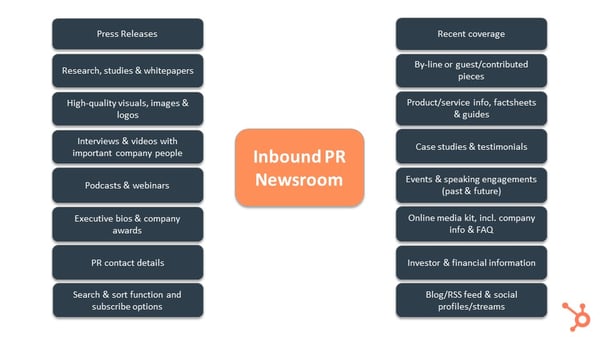
The media newsroom is really helpful as well when it comes to nurturing your leads because it's a really easy way for you to point these people to the right direction where you already got the content. Lead nurturing can be applied to all of the stakeholder personas – it's not just our prospect as we've traditionally tried to do it. It could really be anybody and as long as you have the right tools, it will be easy to do. Why? Because you've already set up your personas, you know the questions they're asking throughout the buyer's journey, and lead nurturing is nothing different than moving your persona from one stage of the buyer's journey to the other and doing it in an automated way ideally, of course, with a software.
When it comes to inbound marketing, I believe you're all familiar with this: ensuring that you use the right tools at the right time to generate the traffic, generate the leads, convert them, depending on whether that's media people you want to work with on creating some coverage or if that's customers you actually want to close for your business to turn them into revenue. This depends again on the goal that you've set out in the beginning, but this can work out just as easily for media people, where you want to grab their attention with something bite-size, something small, when they're in their awareness stage and then make them want more and then, ideally, in some automated shape or form you actually give them that information.
What's quite interesting – and that's going to be one of our challenges for the future, and that's why I said the lead generation really doesn't work unless you have tools – is that with AI, bots, a lot of the IoT, technologies and things that are coming up, a lot more things will become available to us and will become a lot easier for us to do to achieve those lead nurturing results we want. This is really cool research as well that you can guys leverage, but I think what's really scary here is that 87% of the workforce expect part of their jobs to be automated. Who finds that scary? 87%? It's a lot, right? But this is an opportunity for us because what tools cannot do, and what technology cannot do for us, is think and create a strategy because the tools they enable that, but you're going to have to come up with it.
- Measure Results: To close the loop, we've looked from personas and their journey. We've looked through content creation and promotion. We've looked through media relations and also lead nurturing for it. We need to measure the results. We said in the beginning that PR has been notoriously known for not doing this very well, and the data really is out there. There are a bunch of tools. HubSpot is also one of them, but Google Analytics – there's a ton of things that are free that we just need to learn to leverage. One tool like that is AMEC’s framework. The whole idea is that you need to plan with outcomes and the results you're hoping to achieve, not the outputs. It's great to have ideas like using a blog or Facebook advertising, but you really need to start from the overarching strategy and goals that you're setting and then define the right tactics to make that happen.
HubSpot is your best friend. A lot of you here, I'm hoping, are happy with the software, but it's quite helpful for you to apply that for any stakeholder persona and it really allows you to drive results throughout the entire flywheel.
Quick Recap
With inbound PR, you want to set your goals, you want to nail your stakeholder personas and their buyer journey. Through proper research, you want to create a good content plan and then subsequently content . Make sure you spend 80% of your time actually promoting it rather than just creating. E-mail media relations can be part of that and lead nurturing can help you too. At the end, you want to measure the results because that's hugely important so that you can learn what worked, what didn't, what we can do better, what we can get rid of and what can we try again.
Those are the eight key steps when it comes to trying an inbound PR campaign. The key takeaways really are around how it's time for the PR industry to reinvent itself, and you can actually learn a lot from inbound marketing. It really is just about deciding on the persona, getting to know the persona, especially if it's the media persona. These guys also do their research. They make decisions similar to how consumers do and prospects do, so it's just applying the learning to a different persona.



